
by Steve | Jan 12, 2018 | January-February 2018, Magazine, Magazine Articles

Panelists addressed attendees at the Uniting Methodist Conference. The panelists (from left) are: The Revs. Tom Berlin and Jasmine Smothers, Helen Ryde, Neil Alexander and the Rev. Rachel Baughman. Photo by Kathy L. Gilbert, UMNS.
By Kathy Gilbert-
As The United Methodist Church faces a decision on how to include LGBTQ people, those attending a conference grappled with the issue by asking themselves: What would Jesus and John Wesley do?
The Uniting Methodists Conference was held November 13-14 at Impact Church in Atlanta, a United Methodist multicultural congregation led by the Rev. Olu Brown. Approximately 300 people sat in round tables inside the sanctuary while another 100 joined online from 50 locations across the U.S. and the globe.
“Our stance is Jesus; everything else is conversation,” said the Rev. Mike Slaughter, retired pastor of Ginghamsburg United Methodist Church, in one of three worship services held during the gathering.
Uniting Methodists was formed in 2017 from what organizers termed the “vibrant” center of the denomination. The group advocates for the church to stay united by changing church policies to “allow but not compel” pastors to officiate at same-gender weddings and let conferences decide whether or not to ordain LGBTQ clergy.
Since 1972, The Book of Discipline, the denomination’s lawbook, lists both the blessing of same-gender unions and being a “self-avowed practicing” gay clergy member as violations of church law.
The Uniting Methodists Conference states, “We’re a church that holds together both an evangelical desire to lead people to Christ and a passion for justice. We hold together an emphasis on both grace and sanctification. Our church includes moderates, conservatives, and liberals, and we know that we are stronger because of it.”
David Field, author, theologian and a member of the Commission on a Way Forward, presented two lectures that focused on the theology of the denomination’s founder, Wesley. “It takes courage to love every soul God has created,” Field said, explaining what Wesley preached. “We are to support each other’s ministry, pray for each other and view each other in the best positive light,” he said. Rather than judging others, Wesley said, “Judge yourself harshly,” Field said.
The gathering also heard from two other members of the Commission on a Way Forward, the bishop-appointed group charged with recommending ways to move The United Methodist Church beyond its impasse on homosexuality.
The Rev. Tom Berlin, lead pastor of Floris United Methodist Church in Herndon, Virginia, and the Rev. Jasmine Smothers, lead pastor of Atlanta First United Methodist Church, reflected on the work of the commission and the special General Conference 2019. Another member of the Commission on a Way Forward, Dave Nuckols, was also in attendance but did not speak from the podium.
“There is no magic wand,” Berlin told the gathering. “You have to be self-feeders. We are in hard times. The key issue of The United Methodist Church is vitality. The LGBTQ issue is an important issue, but the bishops have told us everything is on the table.”
Smothers preached on Mark 2:1-12 about the four friends who pushed through a large rowdy crowd to bring their paralyzed friend to Jesus. They ended up carrying him on a mat to the roof and digging a hole to lower him in front of Jesus. As those four men were pushing through the crowd they couldn’t have been too nice or they never would have made it, Smothers said. “The world needs to know people love them,” she said. “Stop worrying about your pension. Get a mat and carry them to Jesus!”
Helen Ryde, who called herself a queer person and is the Southeastern regional organizer for Reconciling Ministries Network, said it is time for bravery. “I really believe there is a person in every church who is having inclusive thoughts, but they are terrified they are the only one,” she said. “We have to get brave enough to turn to the person next to us and say that. The majority of United Methodists long for space for all of us.”
Ryde, who said she was only speaking for herself and not Reconciling Ministries Network, told United Methodist News Service she wants the church to roll everything back to pre-1972. That’s when the language around homosexuality being incompatible with Christian teaching was introduced into the denomination’s Book of Discipline.
She said putting people in a position to disagree about including LGBTQ people by allowing individual churches or conferences to decide these issues would be more harmful than the way things are now. “It wouldn’t allow for the thriving of LGBTQ people,” she said.
In a panel discussion called, “Here I Stand,” the Rev. Stan Copeland said he is a traditional compatibilist, and he said many of the people in his congregation at Lovers Lane United Methodist Church in Dallas are from both traditional and progressive sides. He said for the last five years, 68 to 70 percent of new members in his church are coming by profession of faith and baptism. The United Methodist Church has a wide table where all are welcome, he said.
“We must not be brought to our knees by a culture bent toward divisiveness, nor bow at the altar of division and separation. We are called to transform this culture and our warring madness. We make a stronger statement for unity through our rich diversity,” Copeland said.
In her closing sermon, the Rev. Ginger Gaines-Cerilli, lead pastor of Foundry United Methodist Church in Washington, talked about the epidemic of the “UVT” virus, Us vs. Them. “We are called to the difficult and prophetic task of countering status quo—us versus them is not the only way to live.”
Many attendees said they found the conference hopeful and welcoming. “I’m deeply grateful that queer voices were welcomed at the Uniting Methodists Conference, and while it remains to be seen if we will be intentionally factored in, I remain hopeful that the center will be moved closer to the marginalized so marginalization is no more,” said the Rev. Alex Souto, a member of the United Methodist Queer Clergy Caucus.
Kathy L. Gilbert is a multimedia reporter for United Methodist News Service.
![His Eye is on the Sparrow]()
by Steve | Jan 12, 2018 | January-February 2018, Magazine

Original art by Sam Wedelich (www.samwedelich.com).
By Courtney Lott-
“Is not this the kind of fasting I have chosen: to loose the chains of injustice and untie the cords of the yoke, to set the oppressed free and break every yoke? Is it not to share your food with the hungry and to provide the poor wanderer with shelter – when you see the naked, to cover him, and not to turn away from your own flesh and blood? Then your light will break forth like the dawn, and your healing will quickly appear; then your righteousness will go before you; the glory of the LORD will be your rear guard.”
– Isaiah 58:6-8
A Liam Neeson movie shattered my worldview. Though a stint in Peru opened my eyes to poverty and hardship, there were many ways in which I still saw things through youthful idealism and ignorance. Yes, evil certainly still existed, but many of the dark and desperate things had died with history, hadn’t they?
Then, in 2009, I rented Taken.
Horror and anger coursed through me as the movie went on. By the end I cheered the death of every individual who had kidnapped, drugged, and trafficked the young women in the story. I wanted worse for them. I wanted justice. I comforted myself with the thought that it was nothing more than Hollywood fiction, a well-written story that couldn’t possibly reflect reality. The rage I felt in learning that human trafficking does, in fact, continue, and that Houston is one of the largest hubs in the United States, was unlike any fury I’d ever experienced before.
Not in the U.S. Not in my state. Not in my own backyard.
My desire for justice intensified as I started to discover statistics. It is estimated that there are 28 to 30 million trafficking victims worldwide; roughly 80 percent are women, 50 percent are children; the average age of entry into the industry is twelve-years-old. According to the anti-trafficking organization Polaris Project, “traffickers use violence, threats, deception, debt bondage, and other manipulative tactics to force people to engage in commercial sex or to provide labor or services against their will.” Victims of trafficking can be anyone, but populations, such as runaways, are often specifically vulnerable.
Why did it take a Hollywood action movie to open my eyes? Why weren’t there riots in the streets, large demonstrations demanding the end of modern day slavery? Where were the impassioned speeches or heartbreaking images? I headed for my first awareness meeting. As I listened to the speaker, my spirit lifted some. The cry for help was being addressed. Someone representing the faith community was working to free modern day captives.
Around that same time, husband-and-wife team Dennis and Bobbie Mark were opening their home to a 17-year-old trafficking victim. Though they had long worked with these modern day slaves, the couple had only recently begun to ask the question, “What’s next for these women?” It was one thing to get the girls out, but what then? They quickly discovered that they had a lot to learn about how to help those they had rescued from bondage.
Founded in 2005, Redeemed Ministries started as a mission sending organization, with a specific focus on trafficking in places like Thailand and Aruba. As the organization grew, its workers soon realized that what they saw in other countries was happening here in the United States as well. It was then that they shifted focus from foreign mission fields to local ones. Much work was being done for victims in other countries, while most in the United States were left high and dry with very little, if any, advocacy at all.

Victims of human trafficking find sanctuary at the Sparrow House.
Redeemed Ministries started their work in strip clubs and soon expanded to “massage parlors.” It was a difficult process. Dennis Mark describes these early years as sort of a language school for the commercial sex industry. Those in the business had their own lingo, their own culture. In order to get behind enemy lines, volunteers had to learn how to communicate in a way they would be heard. One wrong word and the door would slam shut in their faces.
Moreover, once the victims had been freed, it became unclear where exactly to send them and how best to help them recover. According to Bobbie Mark, there are only about 400 beds for sex trafficking victims in the country, as most do not qualify for domestic violence shelters. Because law enforcement agencies have nowhere to house the individuals they pick up, the only other option is jail.
In 2010, Redeemed Ministries established Sparrow House. Designed as “a long term care facility to provide the initial care needed to begin restoration and rehabilitation toward a life of wholeness and independence,” this house is a safe haven for women rescued from the industry. They started with two girls. As residents are free to leave the yearlong program at any time, one left after only two nights. Since then, Sparrow House has helped many women recover from their years as sex slaves.
Redeemed Ministries now focuses heavily on aftercare and provides extensive training for its volunteers. Those who wish to join the cause have a variety of opportunities to serve. From brothel outreach to prison ministry (W.I.N.G.S.), the organization serves trafficking victims at any and every stage of their dark and difficult journey. According to Dennis Mark, their efforts have even brought about changes within the judicial system.
A few years after I found out about human trafficking, I ran in a 10K for a ministry called Free the Captives. This Katy, Texas-based ministry works with those who are trafficked internationally. At the beginning of the race, before we set off, a former victim took the platform to tell her story. Her final words struck me so deep that I began the race blurry-eyed with tears. She spoke of praying for her trafficker, her pimp, the man who had put her in chains, of praying that God would change his heart, and that he would know what it means to be forgiven. How could anyone pray such a thing for someone who had wronged them in the worst possible way? This woman’s attitude was evidence of God’s power and grace; of the new life he gives when he frees us from the chains of sin.
Though the road is difficult, full of victories and setbacks, the prayer of the ancient prophet is being heard and the oppressed are being set free. As we know from the Old and New Testaments, there are some circumstances that are only transformed through prayer and fasting. As we read in Isaiah, “Then your light will break forth like the dawn, and your healing will quickly appear.”
Courtney Lott is the editorial assistant at Good News.

by Steve | Jan 12, 2018 | January-February 2018, Magazine, Magazine Articles

Nguyen Trung Dung was a Buddhist in his native Vietnam. He was guest worker in East Germany who climbed the Berlin Wall to seek asylum and his since become a Christian. He worships at Tin-Lanh United Methodist Church in Frankfurt, Germany. “I have new brothers and sisters in the church,” he said. Photo by Mike DuBose, UMNS.
By Vicki Brown-
The Rev. Chi My Nguyen’s journey to become the only Vietnamese United Methodist pastor in Germany began in peril. Nguyen and his wife almost died when they fled Vietnam by boat in 1982. He had become a Christian in 1979 and wanted to have the freedom to practice his faith, as well as better opportunities for his family. The fishermen they paid for the trip out of Vietnam robbed them and assaulted his wife, Nguyen said. A storm threatened the boat. Before it sank, a German ship rescued the refugees.
Nguyen studied theology at Reutlingen School of Theology, where he learned about The United Methodist Church. His first church was a village church outside Frankfurt, with mostly elderly members. He said he loved the pastoral care work that was the bulk of his work there. Then in 2004, the bishop approved a Vietnamese church, the Hoi Thanh Tin-Lành Giam Ly Church, or Gospel United Methodist Church, which meets in the United Methodist Church-Frankfurt City. There are between 5,000 and 6,000 Vietnamese in Frankfurt.
“We are here 10 years, but we only have 40 people. We want to reach more for Christ,” Nguyen said. Nguyen ran a restaurant during the time he was a part-time pastor, but he recently sold it because he began a full-time appointment in September serving both Tin-Lành and a German church. Building the Vietnamese church has been a slow process, with Nguyen meeting people on the street, visiting their homes, inviting them to church.
He struggles with the question of one day returning to Vietnam. “If it is the will of God, I would go back,” he said. But he loves his work in Germany and doesn’t really want to go back. About 40 people belong to the church. Members also meet in 20 house churches for study and fellowship in the neighborhoods where they live. Most of the members live a distance away from the central area of Frankfurt where the church is.
“The goal is to have groups, churches, so that everyone has two meetings a week,” Nguyen said. Many Vietnamese refugees to Europe settled in France, but a second wave of Vietnamese immigration came from guest workers in East Germany.

The Rev. Chi My Nguyen (left) visits with parishioner Nguyen Trung Dung at his sushi restaurant in Frankfurt, Germany. Nguyen is the only Vietnamese United Methodist pastor in Germany, serving a church of about 40 immigrants in Frankfurt. Photo by Mike DuBose, UMNS.
Nguyen Trung Dung, a member of Tin-Lành, was a guest worker in East Germany who climbed the Berlin Wall to seek asylum. “At that time they didn’t shoot people, they would have just sent me back to Vietnam,” he said. He owns the Shisankaitan Sushi Restaurant in Frankfurt.
“He’s a boat person, I’m a wall person,” he jokes, pointing to his pastor.
He was a Buddhist brought to The United Methodist Church by an aunt of his former wife. “I feel the family atmosphere at the church. Sometimes I felt so lonely before I became a Christian. I have never known this atmosphere before, I have new brothers and sisters in the church,” he said. “We talk about what’s going on, what work is like, my family.”
Vicki Brown is editor of United Methodist News Service.

by Steve | Jan 12, 2018 | January-February 2018, Magazine, Magazine Articles
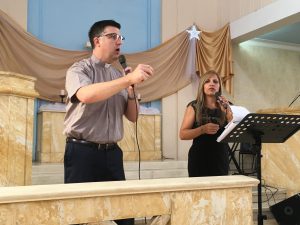
Dr. David Watson preaches in Vedado Methodist Church in Havana, Cuba, as Aylen Font Marrero translates the message. Photo by Steve Beard.
By Chris Ritter-
If there is a spiritual awakening waiting for the United Methodist Church, an essential ingredient of that renewal will be reclamation of Scripture as divinely inspired and authoritative. But there is more. John Wesley was clear that holding right opinions about the Bible and Christianity is not enough. In his sermon, “The Way to the Kingdom,” Wesley wrote: “A man may be as orthodox as the devil … and all the while be as great a stranger to the religion of the heart.”
We who seek the recovery of classic Methodism too often focus on the first half of the equation and not enough on the heart. Being the academic dean of a major United Methodist seminary, we might cynically expect Dr. David Watson to be of little help on either score. But there is ample evidence to the contrary. The latest is Scripture and the Life of God: Why the Bible Matters Today More Than Ever, his recent work offered by Seedbed.
We needed this book. When major evangelicals leave an orthodox understanding of the faith, they often write something explaining why they are really “still in” in all the ways that matter. These publications invariably end up being about the Bible, tenderly highlighting its supposed inadequacies like a pet owner might speak of their ugly, misbehaving dog: “We love it anyway and wouldn’t trade it for anything.” So we have this growing library of recent works describing the ways in which the Bible is inadequate for moral decision-making today. It is easy to lose sight of the fact that we are the ones who desperately need critiquing. While not making this the sole focus of his book, Watson offers a clear response to the claims of these authors.
He does so by reclaiming the Bible as scripture. Not merely a collection of ancient writings to be studied and debated, Scripture is an instrument God uses to communicate to those he loves. Watson does not abandon critical biblical scholarship, but neither does he treat it as an end in itself. The purpose of the Bible is nothing other than our salvation. He is very helpful in Chapter Two describing how this process works.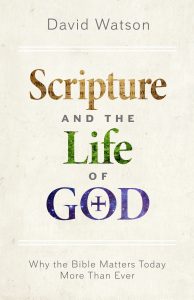
As I write, there is a growing list of notable figures being exposed publicly for how they have exposed themselves privately. Hollywood is in crisis as it feeds the very culture of exploitation it wants to stop. Our political leaders are just as guilty and just as helpless. Being an institution involving humanity, the Church is in no way immune. But Watson reminds us that we hold the medicine in our hands. We have something to offer the bruised and battered refugees from the sexual revolution: “God is the great physician, we are the patients, and God’s medicine bag is the church. Within the church, we hold the delicate instruments by which God heals our wounds, our sin, our brokenness,” writes Watson. “The faith passed down through the centuries, our practices of worship, our common prayers and confession of faith, and, yes, the Bible, are means by which God applies the medicine of the Holy Spirit.”
Watson offers a central metaphor for salvation throughout the book: entering the life of God. Scripture is not merely a way to learn about God, but a means of being encountered personally by the living God. We are invited to an “inexhaustible fountain” of God’s love when faithfully engaging with scripture toward this intended purpose.
This approach to biblical inspiration avoids many of the potholes of the well-worn biblical inerrancy debate. Through the “God-breathed” text, the living God continues to breathe on us. But Watson does not use a devotional approach to scripture to mask over the genuine difficulties that come when we attempt to reconcile the ancient culture of the Bible with our own. The final chapter of the book is devoted to tackling these issues head-on. The Wesleyan tradition offers much to assist us.
I was delighted to also find a chapter highlighting the supernatural works of the Holy Spirit in scripture and today. Here is a United Methodist academic dean that believes in miracles! Watson blends C.S. Lewis’ reasoned defense of the supernatural with his own encounters with the global church in places like Cuba. The chasm between the supernatural world of the Bible and the mundane existence of our own lives is bridged as we plunge afresh into the life of God.
I cannot help but notice that Watson’s voice is part of a growing chorus of leaders in United Methodism becoming more open about their experience with the supernatural gifts of the Holy Spirit. (Let me take this opportunity to “come out,” too, as a charismatic.) While the excesses and theology of all charismatics cannot be defended, there is an unmistakable fire at the roots of our Wesleyan tradition. These embers gave rise to Pentecostalism (the fastest growing type of Christianity globally) and are smoldering up again just when we need it the most. My heart always jumps a bit when someone speaks of this.
If Watson is an odd duck as a keen academic deeply interested in the supernatural workings of the Holy Spirit, he swims in the same pond as John Wesley. Both fearlessly call us to raise our level of expectation. The biblical miracles describe God’s mighty acts of salvation in history and also provide a template for what God wants to do today.
If your church has been passing around copies of Adam Hamilton’s Making Sense of the Bible or Rob Bell’s What is the Bible?, I recommend introducing Scripture and the Life of God into the discussion. Dr. Watson has a gift for clarity that is critically needed in these morally and intellectually muddy days. The book is eminently readable and contains some helpful discussion questions at the end of each chapter. Adult Sunday school classes, church leadership groups, clergy covenant groups, and small groups will find this a helpful resource.
We can be thankful to Seedbed for continuing to “sow for a great awakening.” Reclaiming the power and authority of Scripture in the church is essential to the recovery for which we pray. Could it break forth in our lifetime? David Watson believes in miracles. So do I.
Chris Ritter is the author of of Seven Things John Wesley Expected Us to Do for Kids (Abingdon) and Directing Pastor of a multi-site ministry in Illinois that includes Geneseo First United Methodist Church and Cambridge United Methodist Church.

by Steve | Jan 12, 2018 | January-February 2018, Magazine, Magazine Articles
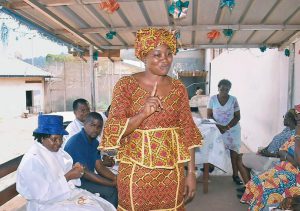
United Methodist regional missionary Finda Quiwa encourages incarcerated women in Freetown, Sierra Leone to “Never give up. Trust God, and things will change.” Photo by Phileas Jusu, UMNS.
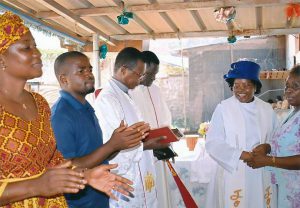 By Phileas Jusu-
By Phileas Jusu-
Encouraged by regional missionary Finda Quiwa to “keep the faith, fight the good fight, and continue to trust in God,” seven inmates of the Freetown Female Correctional Center were baptized and confirmed in The United Methodist Church. The women led choruses — a practice now very popular among them — before the Rev. Daisy Gbloh conducted the November baptism and confirmation service. (The correction center is located in Freetown, the capital and largest city of the west African nation of Sierra Leone. There are 225,000 United Methodists in Sierra Leone.)
Rejoicing as they celebrated Christ’s presence in their lives, the new confirmands took their first sacrament of Holy Communion. Supported by volunteer pastors and laity, United Methodist regional missionaries Elmira Sellu and Quiwa serve the Sierra Leone Annual Conference prison ministry.
Quiwa called the occasion an historic event in the lives of the women and a day of joy for the prison ministry. She encouraged the inmates, “Never give up. Trust God, and things will change.” Over the years, volunteers have led devotions and Bible study, counseling sessions and skills training to help focus on the lives of the women after incarceration.
According to Quiwa, United Methodist volunteers were the first to go into the correctional center. She recalled that even during difficult moments, when people outside the prison were refused entry, the United Methodist prison ministry was allowed into the correctional center.
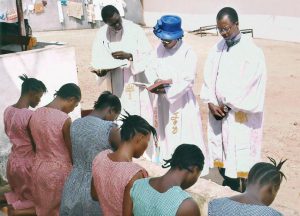
The Rev. Daisy Gbloh (center, standing), supported by the Rev. Winston Ashcroft and the Rev. Alex Josiah, baptizes a woman at the Female Correctional Center in Freetown, Sierra Leone. Photo by Phileas Jusu, UMNS.
“The message of hope — that God can restore us, no matter what crime we have committed” — influenced their decision, she said. “We believe there is life after prison,” Quiwa declared. 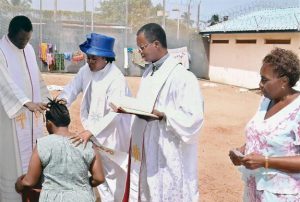
Often, released prisoners are shunned by society and lack skills that can make them self-reliant. “But with skills training, they can have a vocation to rely on to make life meaningful after detention,” she said. “We teach them simple things like floral and balloon decorations, tailoring, hall decoration, soap making, arts and crafts.”
The ministry is also involved in advocacy with government officials for the release of those with whom they work. “We thank God,” Quiwa added, “that most of them join The United Methodist Church after they are released.”
She remembered a former prisoner who now attends Brown Memorial United Methodist Church. The Brown women — who gave the woman business startup funding — supported her, and she is doing well. Another former inmate, who now attends Bishop Baughman United Methodist Church, is also succeeding.
Recalling Jesus’ words, “When I was in prison, you visited me,” Quiwa said, “We give hope; we give courage to restore them so that they cannot return to the issues that caused them to go to jail in the first place. Sometimes, they have served in our churches as examples for people not to go into crime and to see that no matter how difficult this life can get, Christ has a way out.”
Sellu congratulated the women on the bold step to give their lives to Christ and become baptized. She asked them to continue to make amends, do what is right, and move forward in life. “There is nothing impossible with Christ,” Sellu continued. “One day, you will become free to serve the Lord.
“I really felt good and gratified that our ministry is making such a difference in the lives of prisoners,” Sellu said, adding that the high point was “when water was poured on their heads, the genuine tears that flowed freely down the cheeks of the converts and the commitment they made to serve the Lord at all times.”
One woman expressed “thanks and appreciations to God Almighty and the United Methodist prison ministry, the regional missionaries and volunteers for the courage, hope and love” shown them.
Phileas Jusu is director of communications for The United Methodist Church in Sierra Leone. Joe Edward Pormai, a volunteer who works in the United Methodist Women’s regional missionary office with Finda Quiwa, contributed to this story.

by Steve | Jan 12, 2018 | January-February 2018, Magazine, Magazine Articles

“Salvator Mundi” – “Savior of the World” – By Leonardo da Vinci.
By Steve Beard-
The art world is in a high-dollar tizzy after a controversial Leonardo da Vinci painting of Jesus sold for nearly half a billion dollars. The mid-November auction “saw a tense 20 minute battle between at least six bidders,” reported Newsweek. “Observers in the room whooped, cheered, and applauded when the sale was finally confirmed.” Now registered as the highest priced piece of art in history, the 26-inch high painting portrays Christ in a flowing blue Renaissance-era robe holding a crystal orb in one hand and making the benediction blessing sign with the other.
The painting’s magnetic draw was not surprising. Remarkably, there are less than 20 Leonardo (1452-1519) paintings known to exist – and all others are displayed in museums. He was a trailblazing inventor, mathematician, and artist who is most well-known for his paintings “Mona Lisa” and “The Last Supper.”
The final price tag of $450 million for “Salvator Mundi” – Latin for “Savior of the World” – was jaw dropping, especially considering the opening bid was $75 million. The entire transaction puts this piece of art into a stratosphere without peer. Interestingly, there is a fascinating history that accompanies the artwork, as well as some very big unanswered mysteries.
At different stages over the last 500 years the portrait was owned by King Charles I of England (1600-1649), vanished from public viewing for 150 years before it showed up in 1900, sold for $59 in 1958 (believed to be the work of a Leonardo associate), someone painted over Christ’s face and hair, it was restored and sold for less than $10,000 at a Louisiana estate sale, appraised as a Leonardo original in 2011, sold to a Swiss tycoon for $75 million, and purchased by a Russian oligarch for $127 million. The last owner had it auctioned off at Christie’s.
One of the unanswered questions is who spent $450 million to purchase the painting. The other question – perhaps more important – is whether the painting is actually authentic. Despite the monumental price tag, there are highly-charged debates about whether the portrait was painted by Leonardo or one of his disciples, Bernardino Luini.
It would not be difficult for theologians and Bible teachers to see points of parallel and contrast between the painting in question and the recorded life of Jesus. Both share colorfully circuitous storylines. There is also a striking juxtaposition between the painting’s price tag and Jesus’ sage warning about wealth, camels, and the eye of a needle. Then there are the heavy questions to be addressed about both the true authenticity of “Salvator Mundi,” as well as the divine nature of Jesus. Faith comes to the forefront in both instances.
For Bible readers, the Gospel of St. Mark records an intriguing exchange when Jesus asked a seemingly odd question of his disciples: “Who do people say I am?” (8:27). What would prompt someone to ask such a question – especially to friends and associates? Of course, Christ was clearly something more than a run-of-the-mill wayfaring prophet. Indeed, what we are to make of Jesus has become a pivotal spiritual inquiry for the last 2000 years. The legendary broadcaster Larry King once said that if he could choose one person from history to interview it would be Christ. King said that he would like to ask “if He was indeed virgin-born,” adding, “The answer to that question would define history for me.”
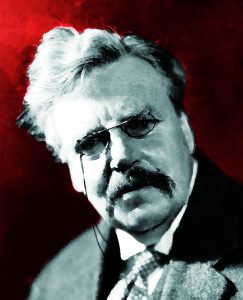
G. K. Chesterton (1874-1936).
The story of Jesus is a patchwork of the mundane and miraculous. St. Mark launches with Jesus being baptized in the Jordan River by a locust-and-honey-eating holy man. From there, Jesus matter-of-factly proclaimed that the “kingdom of God is near,” cast a shrieking demon out of a man at a church service, and healed the sick and possessed. He tried to pray in isolation before sunrise one day but his disciples tracked him down and exasperatedly blurted out, “Everyone is looking for you!” He was clearly a man with a plan – and obviously in demand.
However, he had no world headquarters, no private jet, no mailing list, no Instagram, no cable network TV show. He hiked around the country side with an unlikely gaggle of disciples and preached and drove out howling dark spirits and touched untouchable people. With compassion, we are told, he healed the lepers who were missing ears and fingers and toes.
It was standing room only when he was the guest of honor in a home. In the middle of his talk, a gang of friends ripped open the roof and precariously lowered a paralyzed man into the center of the living room. “Son, your sins are forgiven” were the peculiar and unexpected words the man heard as the atrophied muscles of his legs were revived. Divine forgiveness and an empty stretcher in one fell swoop. Mystery stacked upon mystery.
Thumbing through Mark’s Gospel, there is a story of a shriveled hand that is healed then the salacious allegation that Jesus was himself possessed by Beelzebub. There was the awkward moment when Jesus provocatively asked, “Who are my mother and brothers?” Sure, he was clearly making a point with shock-value, but why provoke the family? Oh yes, and there was a nasty storm incident that left his friends asking, “Who is this? Even the wind and the waves obey him.”
We may feel safer and less anxiety-ridden with the “Sermon on the Mount” Jesus (“Blessed are the poor in spirit, for theirs is the kingdom of heaven”) but the dog-eared pages of a well-read Bible are not shy about revealing stories that seem more like Stephen King novels than Sunday school flannel board stories. The temptation is to sell a domesticated meek and mild Jesus when the stories tell a wild counter narrative.
The out-of-this-world episodes roll through like an out-of-control locomotive. A naked man who cut himself with sharp rocks and lived in a graveyard got a house call from Jesus. The fur flew. Well, in this case, a livid pig farmer went berserk when Jesus cast the man’s demons into 2000 pigs and they charged down a hill straight into a lake. The graveyard dweller was made whole and found some clothes. The pigs didn’t fare so well. They didn’t swim. The irate townspeople ushered Jesus outside the city limits.
On the following pages, there is a dead daughter brought back to life and a hemorrhaging woman made whole when she touched the hem of his clothing. Five loaves and two fish fed thousands – and there were leftovers. Who can forget the legendary adventure of Jesus walking on water?
Eventually we get back to the big question Jesus asked his friends: “Who do people say that I am?” When you read it from front-to-back, the question doesn’t seem so crazy. Jesus’ disciples replied with the only categories they understood, “Some say John the Baptist; others say Elijah; and still others, one of the prophets.”
“But what about you?” Jesus asked his friends. “Who do you say I am?” The impetuous Apostle Peter answered, “You are the Messiah.”
Adding to the enigma, the Bible says: “Jesus warned them not to tell anyone about him.”
While trendy scholars revamp Jesus into a Bible-thumping Che Guevara, time-tested theologians take the abnormalities and fantastical elements of the gospel accounts in stride. They’re not sanguine about the inexplicable, they’re just not revisionistic.
“People have fallen into a foolish habit of speaking of orthodoxy as something heavy, humdrum, and safe,” observed author G.K. Chesterton, English journalist and philosopher. “There never was anything so perilous or so exciting as orthodoxy.” Like it or not, the gospel scenes were either a cosmic charade or Jesus simply played by his own set of rules.
“Mysteries abide at the heart of every religious faith, but the Christian tradition is uniquely comfortable preaching dogmas that can seem like riddles, offering answers that swiftly lead to further questions, and confronting believers with the possibility that the truth about God passes all our understanding,” observes New York Times columnist Ross Douthat.
Responding to pointed questions regarding who painted “Salvator Mundi,” a spokesperson from Christie’s Auction House remarked: “Leonardo’s paintings are known for their mystery and ambiguity.” The painting will remain a controversy that will never fully be laid to rest except for those who wholeheartedly believe in its authenticity.
In a somewhat similar fashion, questions about Jesus Christ have lingered for more than two millennia. Vibrant orthodoxy has embraced the twin prisms of paradox and mystery to envision the complexities and challenges of faith. Yet in an age of internet-quick skepticism, the bombardment of criticism over even an inkling of faith is merciless. Witness what passes as religious dialogue via social media. It is a series of grunts, groans, over the top mockery, and a supposed mic drop – the one liner intended to end the exchange. Unfortunately, both sides utilize this technique. The Good Shepherd, meanwhile, is left voiceless.
“One man’s mystery is another man’s incoherence,” observes Douthat, “and the paradoxes of Christian doctrine have always been a source of scandal as well as strength – not only among atheists, but also among the many honest believers to whom orthodox Christian doctrine looks like a hopeless muddle or else transparent sophistry.”
St. Paul addressed the struggle of looking at the spiritual life with an authentic vision of faith – it had to be something more than mere intellect or emotion. For believers, he prayed that the “eyes of your heart may be enlightened in order that you may know the hope” and “incomparably great power for us who believe” (Ephesians 1:18).
Speaking in truly other-worldly terms, no less than Jesus said that the kingdom of heaven is like an investor searching high and low for fine pearls. “When he found one very precious pearl, he went away and sold all he had and bought it.” For those who believe, this is the journey of faith. To those who seek, Jesus is known as the pearl of great price.
Meanwhile, congratulations are in order for the proud new owner of “Salvator Mundi.” One hopes that the buyer of the painting has stumbled upon the real deal. After 2000 years, Jesus still seems to be a portrait that pops off the canvas.
Steve Beard is the editor of Good News.










 By Phileas Jusu-
By Phileas Jusu-


